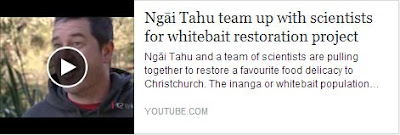This recent information from NOAA is worth a look. It that shows very warm global conditions have prevailed since January.
via GIPHY
Read more about the trend versus historical averages on the Think Progress site here.
And some recent comment on the 10 things you need to know about climate change with implications for New Zealand.
There's a lot going on in the lead-up to the COP21 climate change summit in Paris ... watch this space!
Tuesday, 1 December 2015
Wednesday, 25 November 2015
Te Karere Interview: Ngāi Tahu team up with scientists for whitebait restoration project
Following the announcement of funding from the DOC Community Fund Te Karere TVNZ reporters interviewed the Whaka Inaka project team (including Shelley McMurtrie (project lead), Te Marino Lenihan (project partner) and Shane Orchard (project partner) to find out more about the collaboration between Ngai Tahu and Christchurch scientists.
Watch the news video here
Thursday, 1 October 2015
Whaka Inaka project gaining media attention

Whaka Inaka: Causing Whitebait is a joint collaboration between EOS Ecology, Ngāi Tahu, and the University of Canterbury (UC). We recently receiving funding from the Department of Conservation Community Fund, and together with support from Brian Mason Trust, and businesses such as Ravensdown the project is getting underway!
Friday, 11 September 2015
Coastal Restoration Trust award
 A big thank you to the Dunes Trust for adding their support to our to our dune management case study.
A big thank you to the Dunes Trust for adding their support to our to our dune management case study.Visit www.dunestrust.org.nz for more information on conservation and restoration New Zealand’s dune ecosystems.
Tuesday, 4 August 2015
Collaboration with NIWA to develop salinity models
 The Resilient Shorelines team would like to thank the Brian Mason Scientific & Technical Trust and also NIWA for bringing their support to this exciting research.
The Resilient Shorelines team would like to thank the Brian Mason Scientific & Technical Trust and also NIWA for bringing their support to this exciting research.An interesting though unexpected finding of this work was the discovery of a leak in the Woolston Tidal Barrage. The model calibration was excellent in the lower estuary and in the Avon / Ōtākaro. However there was a strong anomaly between the modelled versus observed salinity datasets for the Heathcote / Ōpāwaho that have been influenced by the tidal barrage leakage. Read more about it here in the Brian Mason Trust report on 'Development of a fine-scale salinity model for the Avon Heathcote Estuary Ihutai'.
Read more here
Friday, 10 July 2015
Earthquakes cause a shift in the location of īnanga spawning sites
One of the main objectives for our whitebait conservation study was to determine if the earthquakes had altered the location of spawning sites for īnanga (Galaxias maculatus) for spawning. They are typically found in specific locations near the freshwater-saltwater interface at rivermouths. As such, īnanga spawning sites are potentially a very good indicator of change. Conversely, they may be especially vulnerable to changes that affect the availability or condition of suitable habitat.
And the answer is - yes, there has been a major shift in the location of spawning compared to all previous records!
Read more here
And the answer is - yes, there has been a major shift in the location of spawning compared to all previous records!
Read more here
Subscribe to:
Comments (Atom)



